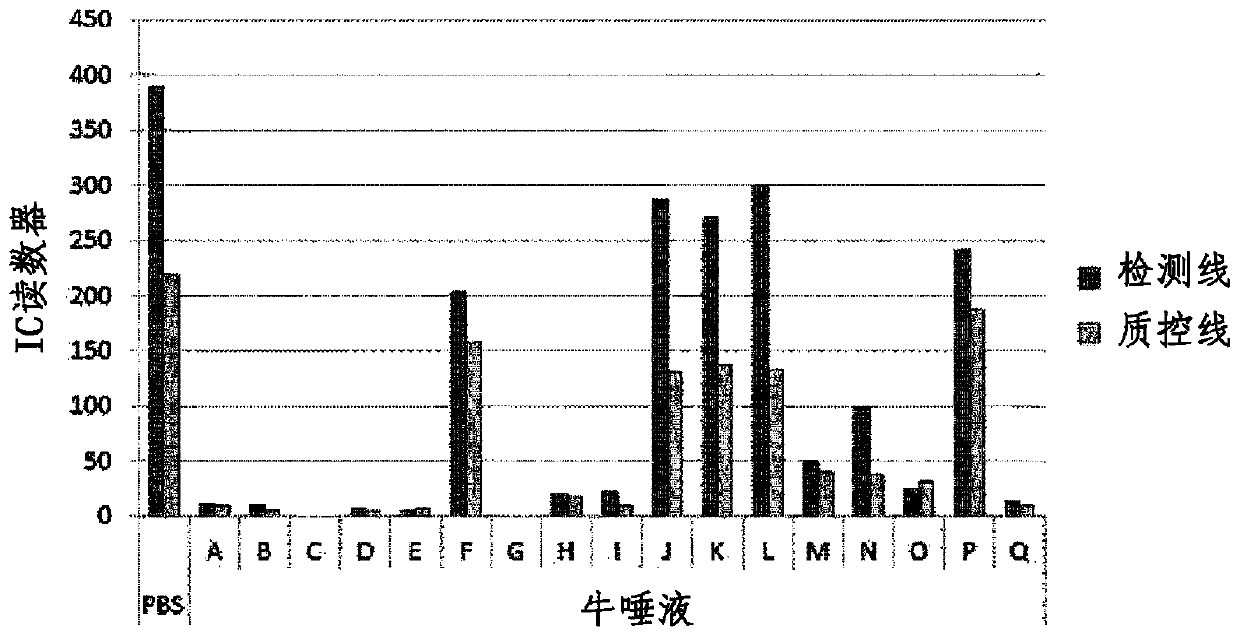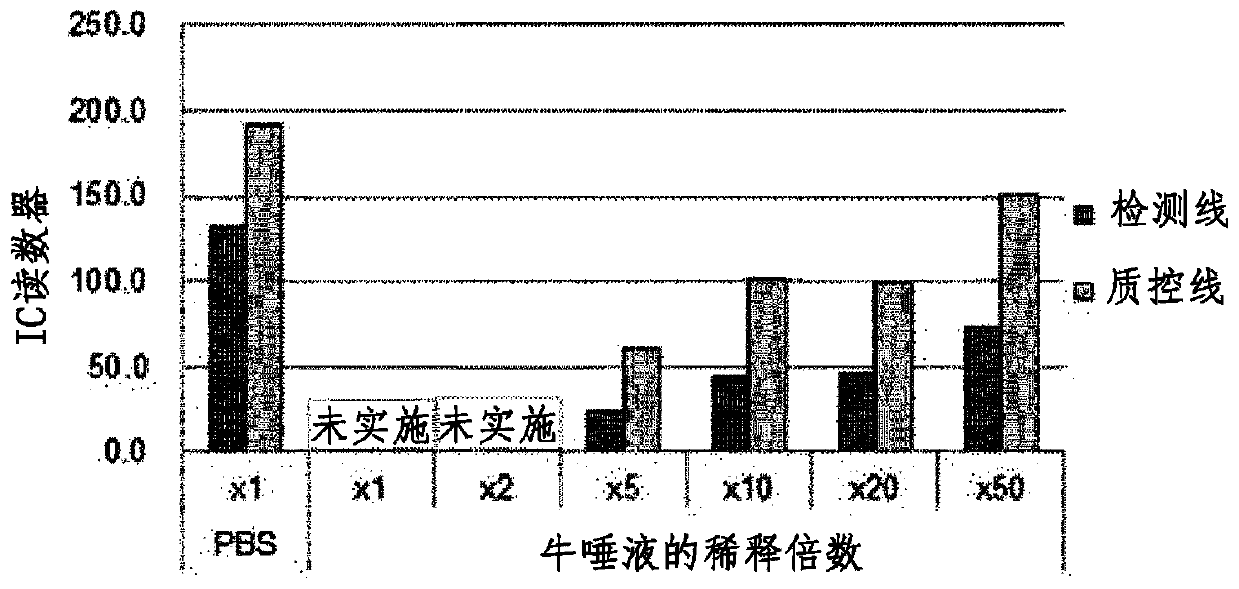Substance that prevents antigen-antibody reaction inhibition by body fluid
A technology of body fluid and immune response, which is applied in the fields of biomaterial analysis, preparation of test samples, measuring devices, etc. It can solve the problems of failing to provide a wide range of antigen-antibody responses and hindering powerful inhibitors
- Summary
- Abstract
- Description
- Claims
- Application Information
AI Technical Summary
Problems solved by technology
Method used
Image
Examples
Embodiment 1
[0168] (Example 1) Immunological reaction hindered by saliva
[0169] (1-1) Detection hindrance of Campylobacter antigen due to saliva
[0170] In this example, in order to observe the inhibition of the antigen-antibody reaction in the immunochromatography for the detection of Campylobacter, 8×10 6 The amount of cfu / mL was added to Campylobacter jejuni (Campylobacter jejuni; ATCC29428) dead bacteria solution and stirred to make a sample, which was added dropwise to the Campylobacter detection immunochromatography (NH immunochromatography Campylobacter (Japanese ham Co., Ltd.), the detection line and the quality control line were measured by an immunochromatography reader (manufactured by Hamamatsu PHOTONICS, C10066) ( figure 1 ). The detection line is coated with anti-Campylobacter antibody, and the quality control line is coated with anti-mouse IgG antibody, which reacts with Campylobacter bacteria and anti-Campylobacter antibody respectively.
[0171] As a result, althoug...
Embodiment 2
[0196] (Example 2) Screening of Immune Response Hindering Inhibitors
[0197] (2-1) Screening from surfactants
[0198] First, various surfactants that were conventionally known to have an inhibitory effect on immune-reaction-inhibiting substances in body fluids such as saliva were tried as candidates for immune-reaction-suppressing inhibitors.
[0199] As surfactants, negative tests and positive tests were performed using various nonionic surfactants and amphoteric surfactants confirmed in Patent Document 1 to have a solubilizing effect on mucin in saliva.
[0200] As in Example (1-2) etc., negative test and positive test were performed using saliva sample (G) under the same conditions as in Example (1-1) using NH immunochromatographic Campylobacter and Campylobacter dilution.
[0201] As a result, sufficient effects could not be confirmed for almost all surfactants (data not shown). Those with relatively higher effects are shown below (Table 4).
[0202] When using sodium t...
Embodiment 3
[0227] (Example 3) Study on the inhibitory effect of immune reaction inhibition of compounds having sulfonic acid groups
[0228] (3-1) Restoration effect of reactivity hindrance caused by saliva sample
[0229] With regard to various sulfonic acid group-containing low-molecular-weight compounds having a straight-chain alkyl group, which are expected to have a high effect of inhibiting immune response inhibition from the results of Example (2-4), we observed the compounds used in Example 1 (1-1). Is the impediment of reactivity to quality control lines caused by bovine saliva samples recovered in immunochromatographic assays for foot-and-mouth disease antigens.
[0230] As a result, it was the linear dodecylbenzene sulfonate that recovered the reaction block of the quality control line at the lowest concentration. Therefore, it is estimated that linear dodecylbenzenesulfonic acid has the highest inhibitory removal effect (Table 8).
[0231] Furthermore, regarding various alk...
PUM
 Login to View More
Login to View More Abstract
Description
Claims
Application Information
 Login to View More
Login to View More - R&D
- Intellectual Property
- Life Sciences
- Materials
- Tech Scout
- Unparalleled Data Quality
- Higher Quality Content
- 60% Fewer Hallucinations
Browse by: Latest US Patents, China's latest patents, Technical Efficacy Thesaurus, Application Domain, Technology Topic, Popular Technical Reports.
© 2025 PatSnap. All rights reserved.Legal|Privacy policy|Modern Slavery Act Transparency Statement|Sitemap|About US| Contact US: help@patsnap.com



